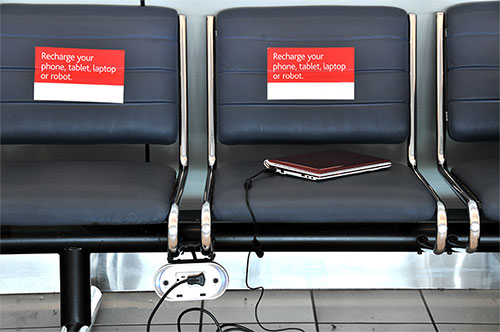 We’re under attack! USB-linked public charging stations can infect our devices and steal our precious data in under a minute.
We’re under attack! USB-linked public charging stations can infect our devices and steal our precious data in under a minute.
Many of us would feel lost without them. In fact, we are so dependent on our mobile devices that we check them every six and a half minutes, according to a study commissioned by Nokia. As devices advance, we’re carrying more information and data on us, making each of us a more efficient road warrior but also more exposed to threat.
Fast forward to the next time you’re running between meetings when you get that devastating alert that your phone is about to die. You frantically look for your charger only to realize that there’s no outlet in sight, and you’re already five minutes late for a customer call. It’s enough to make you want to scream. We’ve all been there, and we’ll be there again.
At first thought, the conveniently located public power station in the airport, shopping mall or around the corner may look like your saving grace. But, you may pay for it in the end.
Jacking Your Juice
Plugging your cellphone into a USB power kiosk grants the kiosk access to download your data – contacts, email attachments, photos, etc. The kiosk may also be configured to install malware onto your device. What’s worse? Any mobile device is vulnerable, and malware programs usually take under a minute to run. The kiosks can read and write data from your device, even if you have the USB data transfer mode disabled.
This becomes an even bigger problem when dealing with sensitive corporate information. The more data that employees are able to access on their smartphone or tablet means more information that’s susceptible to being hacked. Think about the resources that people have access to from their phones. Employees today are carrying the “keys to the castle” on their devices, and if just one plugs into a public charging station, the whole company could be compromised.
As this problem becomes more prevalent, media outlets are starting to build awareness about the dangers. They recommend that you bring your regular charging cable with you when you travel and plug that into plain electrical outlets, or invest in spare batteries for your device – anything you can do to avoid charging stations in public areas.
Don’t Panic
Fear not! We can stop silently cursing our drained devices. There are portable power solutions available that don’t require an electrical outlet and won’t force you to replace your iPhone, Android or tablet battery.
Everybody, every day is concerned about how much power their smart phones and tablets have left and where and when they will be able to recharge.
I want people to know that it’s time to be mindful of what we’re actually carrying with us on our devices. When it comes to charging, we need to keep it close to the vest (or in this case, right at our finger tips). Portable power accessories are out there – the trick is finding one that’s right for you so you can keep your personal data protected, and all your mobile devices powered up.